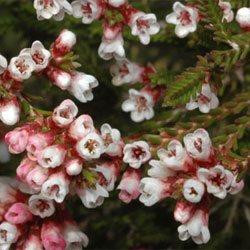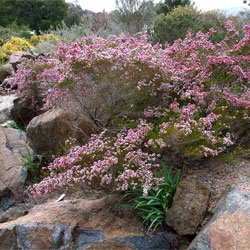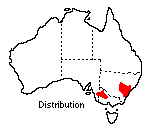Micromyrtus ciliata
 |
 |
Fringed Heath Myrtle
Micromyrtus ciliata (Sm.) Druce
The Fringed Heath Myrtle (Micromyrtus ciliata) is a well-known shrub which
will interest every gardener looking for the choicest plants. Graceful in appearance
yet tough in constitution, it remains healthy for years with little or no attention.
Once established and bushy it stands drought well, but if any branches should
die out it regenerates well after watering. However, adequate water ensures more
lush and continuous growth and must be given for the first years after planting.

Habit varies from prostrate to upright, and the low forms are specially attractive.
With age it may spread over 3 m across, slowly reaching 1 m high with long arching
and tapering branches. In a sunny position growth is dense and stiff - an excellent
ground cover for keeping down weeds. It is spectacular in a large rockery and
lends itself to landscaping design around the walls of buildings as well as to
any slope or front of border.
This species has the tiniest of leaves and flowers among native garden shrubs, but both are of solid substance for their size, and being massed are effective. Leaves are opposite, an arrangement often seen in shrubs of the family Myrtaceae to which also Paperbarks (Melaleuca) belong. lt gives them a neat and clean appearance at all seasons and thus many are valued as foliage plants apart from their flowering interest. The leaves of all are aromatic when bruised and seldom blemished by pests or diseases.
Towards the end of the winter the shrub brightens to carmine as flower buds with reddish calyces develop. The flowers outline the branches in clusters at the end of short lateral stems, and open first low on the branches. Flowers are cup-shaped with five rounded petals, white or flushed pink or red, often mingled on the same plant.
They age to deeper reds and remain firm for many weeks thus extending the season of colour till the end of November. In some years stray autumn flowers appear.
Good seed is difficult to obtain and propagation is by means of cuttings of stem tips taken when half ripened. Young plants can generally be bought from nurseries and sometimes are offered under separate horticultural names according to habit and colour. When planting out they should be given light soil free from lime and they then grow quickly, coming into flower while young. Pruning is optional and a little light trimming is effected if sprays of flowers are cut for decoration. These are easy to arrange and long-lasting in shallow bowls of water. Sometimes as they dry out slowly such stems will keep enough colour to be useful in dried arrangements.
Based on text by Irene Beeton (1971)
Name meaning: Micromyrtus ciliataMicro - small; myrtus - a Myrtle, referring to the Myrtaceae family; ciliata - fringed, alluding to the fringe of minute stiff hairs round the leaves |
![An Australian Government Initiative [logo]](/images/austgovt_brown_90px.gif)

